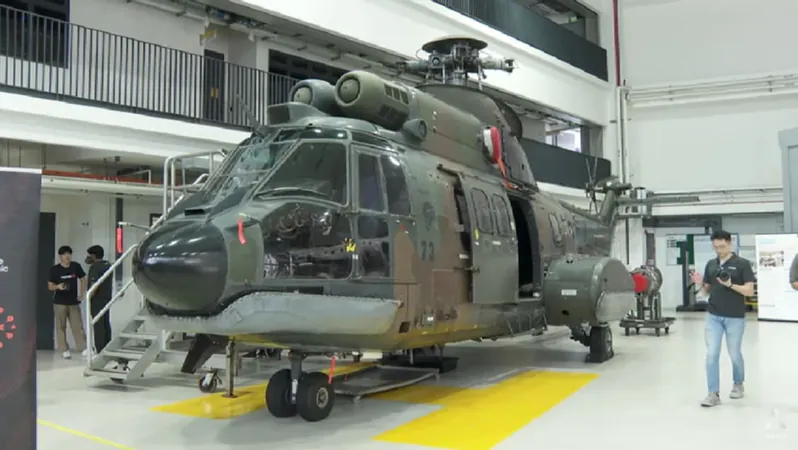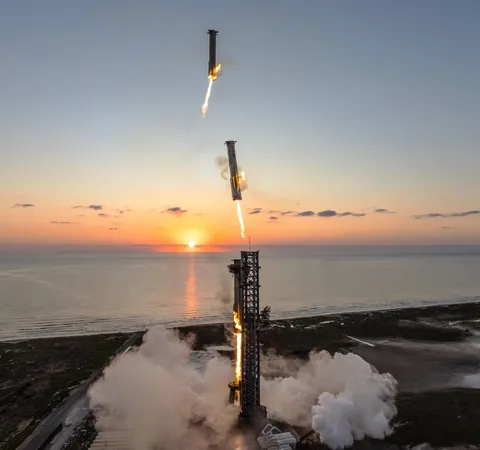
Singapore Polytechnic Elevates Aeronautical Training with Super Puma Helicopter Donation
2024-09-25
Author: Wei Ling
Introduction
In an exciting development for aspiring aerospace engineers, Singapore Polytechnic (SP) has received a generous donation of a Super Puma helicopter from the Republic of Singapore Air Force (RSAF). This remarkable addition to their training resources signifies a strong commitment to equipping students with practical skills that are crucial for success in the aerospace industry.
Hands-on Learning Benefits
Hands-on learning opportunities have been shown to significantly enhance student understanding and retention, particularly in fields as complex as aeronautical engineering. Final-year student Michelle Weng expressed her enthusiasm, stating that working directly with aircraft allows her to grasp intricate concepts far better than conventional classroom lectures alone. The Super Puma, with its advanced digital avionics, offers a modern training experience that reflects current industry standards.
Previous Training Resources
Prior to this, the polytechnic utilized the UH-1 Iroquois helicopter for training purposes, which has successfully served over 13,800 students since its introduction in November 2010. "Practical training is essential for mastering skills like insulation and continuity checks on different components," noted second-year aerospace electronics student Hazirah Jaffar. She emphasized that without such hands-on experience, students might find themselves lost when faced with real-world aircraft maintenance tasks.
Institution's Commitment
Mr. Liew Hui Sing, an aeronautical and aerospace specialist at SP, highlighted the institution's dedication to continuously upgrading its educational tools. "As an educational institution, we must evolve with technology. This aircraft will enhance our curriculum," he stated. Graduates of SP's aeronautical engineering and aerospace electronics programs are increasingly sought after in the job market, with opportunities for career advancement in areas like project management.
Industry Comparison
SP is not alone in its innovative approach to technical education. Ngee Ann Polytechnic (NP) also incorporates advanced training aids, including an Airbus A320 flight simulator and a Dassault Falcon 10 business jet for their aerospace engineering courses. Mr. Ng Ker Wei, director of NP's School of Engineering, emphasized the necessity of hands-on training to bridge the gap between theory and practice in today's complex aircraft systems.
Emphasis on Modern Training Methods
In keeping with industry demands, NP has focused on integrating digital training methods, employing cutting-edge technologies such as artificial intelligence, robotics, and holograms into their curriculum. "We aim to prepare students for the evolving maintenance, repair, and overhaul (MRO) industry," Mr. Ng remarked, affirming the school’s commitment to adapting trainings that meet the needs of the modern aviation landscape.
Conclusion
By investing in tangible, real-world training experiences, Singapore Polytechnic and Ngee Ann Polytechnic are proving that hands-on learning not only builds skill sets but also boosts students' confidence and problem-solving abilities—preparing them for successful careers in the fast-paced and ever-evolving aerospace industry.

 Brasil (PT)
Brasil (PT)
 Canada (EN)
Canada (EN)
 Chile (ES)
Chile (ES)
 España (ES)
España (ES)
 France (FR)
France (FR)
 Hong Kong (EN)
Hong Kong (EN)
 Italia (IT)
Italia (IT)
 日本 (JA)
日本 (JA)
 Magyarország (HU)
Magyarország (HU)
 Norge (NO)
Norge (NO)
 Polska (PL)
Polska (PL)
 Schweiz (DE)
Schweiz (DE)
 Singapore (EN)
Singapore (EN)
 Sverige (SV)
Sverige (SV)
 Suomi (FI)
Suomi (FI)
 Türkiye (TR)
Türkiye (TR)